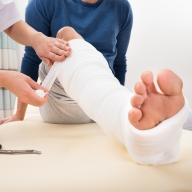Crack! When You Fracture a Bone
Medically reviewed by
Dr. Ardalan Sayan
McLeod Orthopaedics
It bends. Then breaks. And it probably hurts.
Meanwhile, your body is busy working to start repairing the broken bone.
“There are many types of fractures, including just a crack, where you may feel little or no pain at first,” says McLeod Orthopedic Specialist Dr. Sayan. “In another type of break, broken ends of the bone may line up in what we call a stable fracture. Bones can fracture at an angle or in multiple pieces. Or, they can break through the skin in an open, compound fracture.”
AFTER THE BREAK
After the break is stabilized, an amazing process proceeds inside. In a few hours, the body forms a clot around the break, where immune cells work to eliminate germs. Next, another special set of cells creates a soft covering or callus around the break. Over time, this is replaced with a harder covering that is absorbed to make new bone.
THE LIVING BONES
Bones may appear rock-like, but they are living tissue – spongy and mesh-like inside the hard covering — that completely regenerates itself every 10 years in an adult. The process, called remodeling, continually removes old bone tissue, replacing it with new bone material.
In younger people, the body is able to produce sufficient material to keep the bones strong. As we get older, it takes work on our part to keep producing enough healthy bone tissue. If we don’t, bones deteriorate into osteoporosis.
ACTION YOU CAN TAKE
To keep your bones strong, cut down on soda, alcohol and tobacco. Catch some sun each for its Vitamin D or take supplements. Vitamin D helps your body absorb vitamin C, a critical factor for strong bones.
Sources of calcium include dairy products, green leafy vegetables, beans, shrimp, nuts and almonds. Many brands of orange juice are fortified with calcium or vitamin C.
Stop smoking. Tobacco in your system hinders the bones ability to regrow itself. Even if you don’t have a fracture, prolonged tobacco use can lead to weakened bones, osteoporosis and possible fractures.
If you fracture a bone, stop the bleeding, immobilize the injured area and apply cold. Call 911, go to the Emergency Department or see an Orthopedic Specialist as soon as possible. Waiting for treatment may cause the bones to heal badly.
Find an Orthopedic Specialist near you.
Sources include: McLeod Health, American Academy of Orthopedic Surgeons, National Institutes of Health, Arthritis Foundation
-
McLEOD REGIONAL MEDICAL CENTER FLORENCE
843-777-2000 -
McLEOD DARLINGTON
843-777-1100 -
McLEOD DILLON
843-774-4111 -
McLEOD LORIS
843-716-7000 -
McLEOD SEACOAST
843-390-8100 -
McLEOD CHERAW
843-537-7881 -
McLEOD CLARENDON
803-433-3000



-
McLEOD REGIONAL MEDICAL CENTER FLORENCE
843-777-2000 -
McLEOD DARLINGTON
843-777-1100 -
McLEOD DILLON
843-774-4111 -
McLEOD LORIS
843-716-7000 -
McLEOD SEACOAST
843-390-8100 -
McLEOD CHERAW
843-537-7881 -
McLEOD CLARENDON
803-433-3000
 Find a Doctor
Find a Doctor  Locations
Locations  Services
Services 